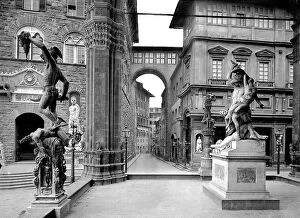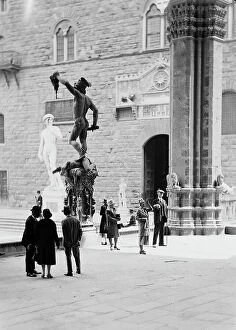Perseusmannerism Collection
Perseus, the magnificent work in bronze by Benvenuto Cellini, stands proudly in the Loggia della Signoria or Loggia dei Lanzi in Florence
For sale as Licensed Images
Choose your image, Select your licence and Download the media
Perseus, the magnificent work in bronze by Benvenuto Cellini, stands proudly in the Loggia della Signoria or Loggia dei Lanzi in Florence. This iconic sculpture captures the heroic figure of Perseus, a mythological hero known for slaying Medusa. In the heart of Piazza della Signoria, visitors are greeted by this masterpiece that showcases Cellini's exceptional craftsmanship. The photo studio perfectly captures the grandeur and intricate details of Perseus as he holds up Medusa's severed head triumphantly. Adjacent to Via della Ninna, one can catch a glimpse of Piazza della Signoria and its captivating atmosphere. Here, alongside other renowned sculptures like Michelangelo's David, Perseus commands attention with his striking presence. Inside the Loggia dei Lanzi, one is transported to another era as they admire Benvenuto Cellini's Danae with Perseus child. This bronze masterpiece from 1545-1554 captivates viewers with its delicate portrayal of motherhood and mythical lore. The Loggia della Signoria itself is an architectural marvel that houses Perseus among other notable statues. From here, one can also appreciate the Vasari Corridor bridge connecting Palazzo Vecchio and Uffizi Gallery—a testament to Florence's rich history. As we gaze upon Palazzo Vecchio from within the Loggia dei Lanzi, our eyes are drawn not only to its majestic facade but also to two prominent figures: Marzocco and Benvenuto Cellini's resplendent Perseus. These statues add an air of regality to this historic setting. Every detail on Cellini's Perseus deserves admiration; it speaks volumes about his mastery over bronze sculpting techniques. Whether it be capturing emotions or intricately depicting Medusa’s head turning into stone under Perseus' gaze—Cellini leaves us mesmerized.














